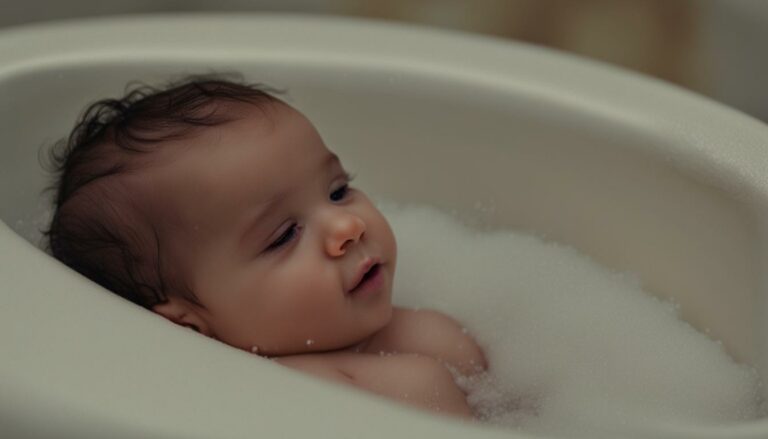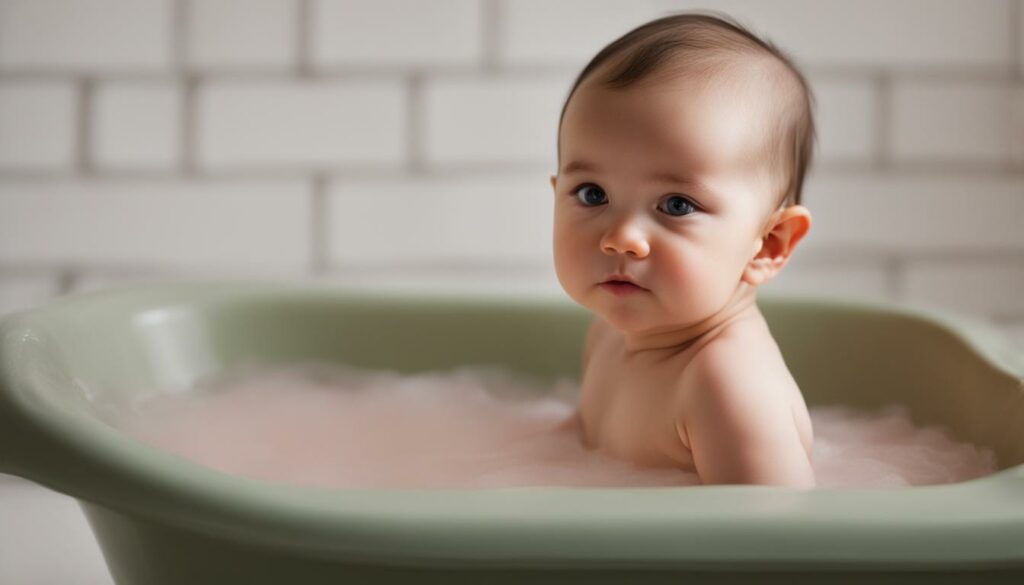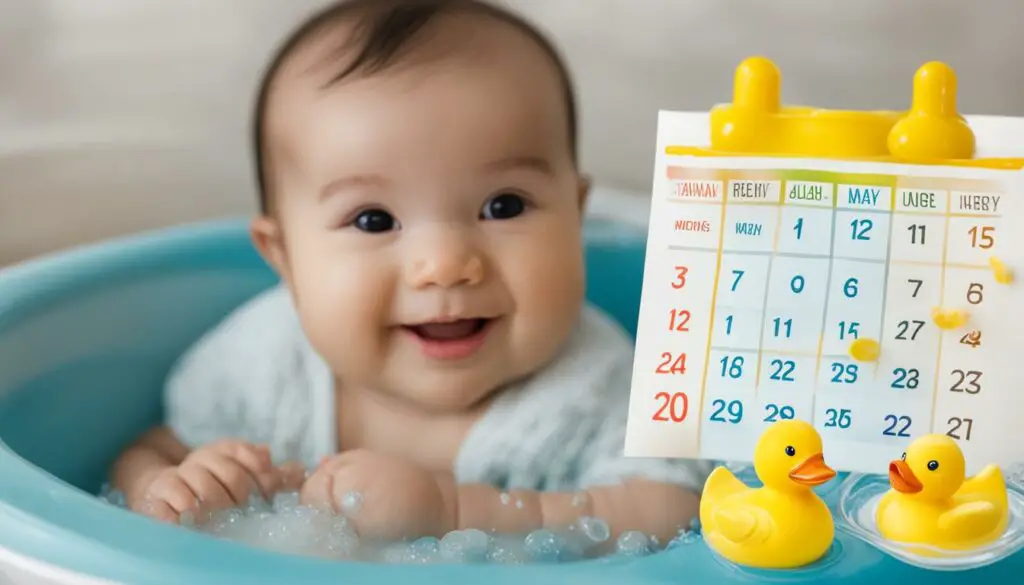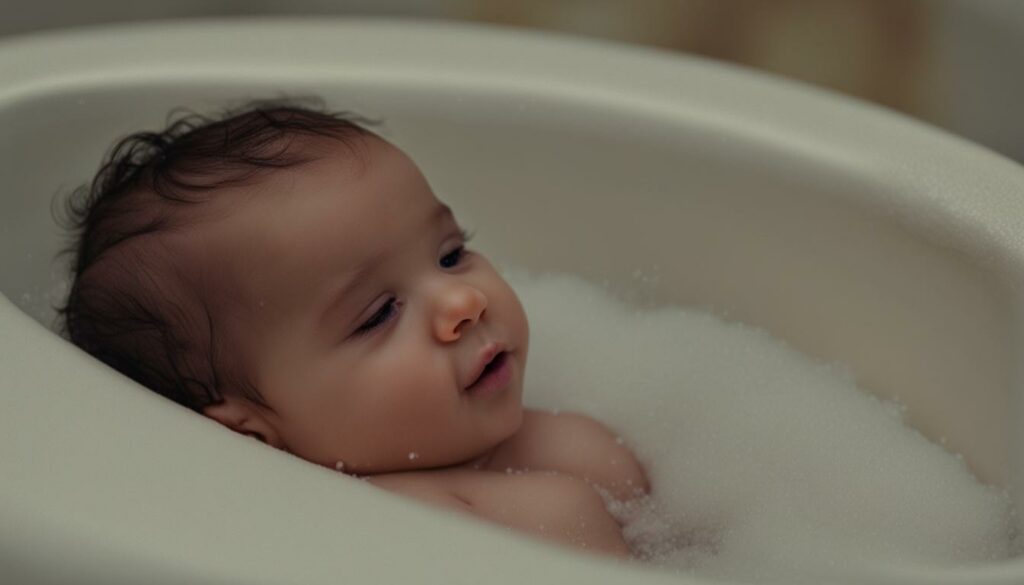If you are a new parent or caregiver, you may be wondering whether it is safe for a baby with a cough and cold to take a bath. The answer is generally yes, but there are some important precautions to take to ensure your baby’s comfort and well-being.
In this section, we will explore the potential benefits and risks of bathing a baby with a cough and cold. We will also provide guidance on how to adjust your bathing routine to ensure your baby’s safety and provide relief for common symptoms like nasal congestion and fever.

Key Takeaways:
- Bathing is generally safe for a baby with a cough and cold, but precautions should be taken.
- A warm bath can help soothe your baby’s airways and relieve congestion.
- It is important to maintain proper hygiene during illness.
- Adjust water temperature and choose suitable bath products to prevent further discomfort.
- Always consult with your pediatrician if you have any concerns.
Understanding Cough and Cold in Babies
It can be distressing to see your baby suffering from a cough and cold. It’s important to understand the typical symptoms and how they may affect your baby’s comfort and health.
Common Symptoms
Some common symptoms of a cough and cold in babies include:
- Coughing: This may be mild or severe and can be accompanied by wheezing or phlegm.
- Runny or blocked nose: This can cause discomfort and interfere with feeding and sleeping.
- Sore throat: Your baby may be irritable and have difficulty swallowing.
- Fever: A fever may be present, indicating an infection.
If your baby is exhibiting any of these symptoms, it’s important to consult with your pediatrician to ensure proper care and treatment.
Causes and Prevention
Cough and cold in babies are usually caused by viruses that can spread through contact with infected persons, surfaces, or objects. Prevention is key, and you can take some steps to reduce the risk of your baby getting sick:
- Wash your hands often, especially before feeding or touching your baby.
- Avoid exposing your baby to people with colds or other illnesses.
- Clean and disinfect surfaces and objects that may be contaminated.
While it’s not always possible to prevent illness, taking these steps can help reduce the likelihood of your baby getting sick.
“Cough and cold in babies are usually caused by viruses that can spread through contact with infected persons, surfaces, or objects.”
Now that you understand the symptoms and causes of cough and cold in babies, let’s explore whether it’s safe to bathe your baby when they are sick.
The Benefits of Bathing for a Baby with Cough and Cold
As a parent, you want to do everything possible to help your baby feel better when they have a cough and cold. While it may seem counterintuitive, taking a bath can actually provide significant relief. Here are some key benefits of bathing for a baby with a cough and cold:
- Soothe airways: When warm water and steam combine in the bathroom, they can help soothe your baby’s airways. This can be especially helpful if your baby is experiencing respiratory illness symptoms, such as congestion and a cough.
- Relieve congestion: The warm, humid air in the bathroom can also help break up mucus and relieve congestion. This can make breathing easier for your baby and help them sleep better.
- Provides overall comfort: Taking a bath can be a comforting experience for your baby, helping them relax and feel better overall.
- Promotes hygiene: Keeping your baby clean is essential during illness to prevent the spread of germs and infection. Bathing can help maintain proper hygiene, particularly if your baby has a fever or runny nose.
Of course, it is always important to prioritize your baby’s comfort and safety, so it’s essential to take certain precautions when bathing a baby with a cough and cold. We’ll explore these in the next section.

Creating a safe and comfortable bathing experience can benefit both you and your baby. Keep reading to learn how to take the necessary precautions and create a steamy bathroom environment to help your baby feel better.
Precautions to Take When Bathing a Baby with Cough and Cold
While a warm bath can provide relief from the symptoms of a cough and cold, there are some precautions you should take when bathing your infant or toddler.
Adjusting the Water Temperature
Be sure to test the water temperature before placing your baby in the bath. Use your elbow or a thermometer to ensure that the water is lukewarm, around 90-100 degrees Fahrenheit. This temperature is soothing for your baby and can help relieve symptoms such as fever.
Choosing Suitable Bath Products
During a cough and cold, it is essential to use gentle bath products that do not irritate your baby’s skin. Choose fragrance-free, dye-free, and hypoallergenic products that are intended for infants and toddlers. Additionally, consider using a humidifier in your baby’s room to relieve respiratory symptoms.
Addressing Specific Symptoms
If your baby has a runny nose, ensure that you wipe it regularly with a soft cloth. Avoid using harsh tissues as they could irritate the skin and worsen the symptoms. Additionally, if your baby has a sore throat, consider using a saline solution to help relieve the discomfort. Consult with your pediatrician about any medications or remedies that may be suitable for your baby’s specific symptoms.
Ensuring Proper Hygiene
During an illness, it is crucial to maintain proper hygiene to prevent the spread of germs. After your baby’s bath, be sure to wash their clothes, towels, and other items that may have come into contact with the virus. Additionally, wash your hands regularly and avoid close contact with other sick people.
By taking these precautions, you can help ensure that your baby’s bath is safe, soothing, and effective in relieving symptoms.
Creating a Steamy Bathroom Environment
Creating a steamy bathroom environment is an effective way to ease your baby’s nasal congestion and open up their airways during bath time. The steam helps to soothe the inflammation in the respiratory system, making it easier for your baby to breathe and relieve congestion.
Here are some practical steps to create a steamy bathroom:
- Close all windows and doors to keep the steam inside the bathroom.
- Run hot water in the shower or bath for a few minutes before starting to fill it with warm water. This will create steam in the bathroom more quickly.
- Place a warm, wet washcloth on your baby’s chest while bathing to further promote steam inhalation and soothe the airways.
Remember to keep the temperature of the bathroom warm, not hot, to prevent overheating. Always monitor your baby’s temperature and comfort throughout the bath to ensure that they are not too hot or too cold.

Creating a steamy bathroom environment is a safe and effective way to help your baby breathe more easily during bath time. By easing nasal congestion and opening up the airways, you can help your little one feel more comfortable and relaxed.
Alternatives to Full Submersion Baths for Baby
If a full submersion bath is not suitable for your baby with a cough and cold, there are alternative methods to provide relief and maintain proper hygiene. These options can be especially helpful if your baby is not feeling up to a traditional bath.
Spot Cleaning
Spot cleaning allows you to clean your baby’s more sensitive areas while keeping them warm and comfortable. Fill a bowl with warm water and use a soft washcloth or sponge to gently clean your baby’s face, neck, armpits, and diaper area. Be sure to pat dry with a soft towel afterward.
Sponge Baths
A sponge bath can be a good alternative to a full submersion bath. You’ll need a basin filled with warm water, a soft washcloth, and a towel. Start by undressing your baby and placing them on a towel. Dip the washcloth into the warm water and wring it out. Use the washcloth to gently clean your baby, starting with their face and moving down to their chest, arms, and legs. Be sure to dry your baby thoroughly afterward.
Steam Shower
If your baby has nasal congestion, a steam shower can help relieve their symptoms. Take your baby into the bathroom and turn on the shower to the hottest setting. Close the bathroom door and let the steam build up for five to ten minutes. Be sure to stay with your baby and keep them in a safe position during this time. The steam should help relieve their congestion and make it easier for them to breathe.
Hygiene Tips
Regardless of which method you choose, it’s important to maintain proper hygiene during your baby’s illness. Wash your hands frequently and use hand sanitizer before and after caring for your baby. Be sure to clean and disinfect any surfaces your baby comes into contact with, such as their changing table and toys. And don’t forget to keep your baby’s nose clean by using a bulb syringe or saline drops to clear out any mucus.
What Bath Products Do I Need for a Newborn? – Essential Guide
Effective Bathroom Baby Proofing Tips for Safe Home Spaces
Conclusion
In summary, it is generally safe for a baby with a cough and cold to take a bath, as long as you take the necessary precautions. Bathing can offer several benefits, such as soothing your baby’s airways and relieving congestion. But it is important to adjust your bathing routine according to your baby’s comfort level and specific symptoms, like runny nose or fever.
Remember to always consult with your pediatrician if you have any concerns or if your baby’s symptoms worsen. Prioritize your baby’s well-being and hygiene by maintaining proper cleaning practices during illnesses.
In situations where a full submersion bath may not be suitable, there are alternative methods to provide comfort and hygiene for your baby. These alternatives can be helpful during times when your baby is not feeling well enough for a traditional bath.
Overall, a warm and steamy bathroom environment can create a soothing and relaxing experience for your baby. Keep these tips in mind and make bath time a comforting and calming experience for you and your little one.
FAQ
Can a baby with a cough and cold take a bath?
Yes, it is generally safe for a baby with a cough and cold to take a bath. However, certain precautions should be taken to ensure their comfort and well-being.
What are the common symptoms of a cough and cold in babies?
Common symptoms of a cough and cold in babies may include a runny nose, nasal congestion, sore throat, and sometimes a mild fever.
What are the benefits of bathing for a baby with a cough and cold?
Bathing can help soothe your baby’s airways, relieve congestion, and provide overall comfort during a cough and cold. It can also promote proper hygiene.
What precautions should I take when bathing a baby with a cough and cold?
When bathing a baby with a cough and cold, it is important to adjust the water temperature, choose suitable bath products, and address specific symptoms like nasal congestion and fever.
How can I create a steamy bathroom environment to help relieve congestion?
To create a steamy bathroom environment, you can run a hot shower before bathing your baby or use a humidifier to increase moisture levels in the air.
Are there alternatives to full submersion baths for babies with a cough and cold?
Yes, if a full submersion bath is not suitable, you can consider using a sponge bath or using damp washcloths to clean your baby.
Can I bathe my baby with a cough and cold if their symptoms worsen?
It is recommended to consult with your pediatrician if your baby’s symptoms worsen or if you have any concerns about bathing them during their illness.





